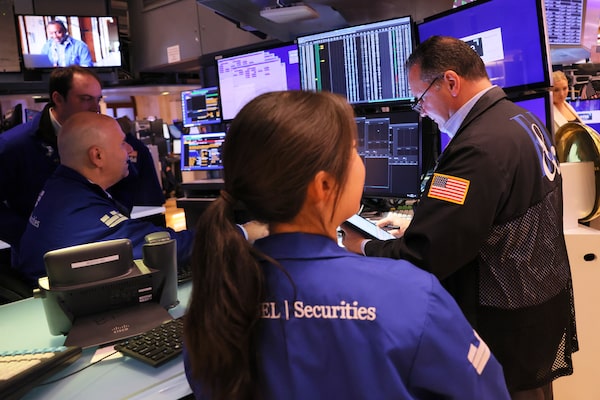The breathtaking pace of political events in Britain is keeping traders on their toes, while Japan is back on intervention watch.
The European Central Bank is expected to deliver another bumper interest rate hike, and earnings season is ramping up with corporates in the United States and Europe facing very different cross currents.
Here’s a look at the week ahead in markets:
Who rules Britannia?
British Conservative MP Rishi Sunak leaves his home address in London on Friday.TOBY MELVILLE/Reuters
Brought down after just six weeks as British prime minister by a radical economic program that rocked markets, pushed up living costs for voters and enraged much of her own party, Liz Truss has quit.
Her Conservative Party, which holds a big majority in Parliament and is not obliged to call an election for another two years, plans to select a new leader by Oct. 28. Former finance minister Rishi Sunak, Penny Mordaunt and previous PM Boris Johnson are all potential successors.
Finance Minister Jeremy Hunt is due to deliver a new budget on Oct. 31. He faces the uphill task of finding tens of billions of pounds in spending cuts - in the middle of a cost-of-living crisis - to rescue Britain’s battered fiscal reputation, with currency and fixed income markets in the doldrums.
Determined dove, hesitant hawk
Exterior of Bank of Japan's headquarters is pictured in Tokyo on June 17.KIM KYUNG-HOON/Reuters
The Bank of Japan meets on Oct. 28 and is expected to continue running against the grain of global central banks by sticking to its extraordinary levels of stimulus - even as its policy exacerbates a politically unpopular plunge in the yen to a 32-year low beyond 150 per dollar.
The BOJ has conducted emergency bond buying for two days running to keep a lid on yields, showing its commitment to easing.
In Australia, the monetary policy outlook is much murkier. The Reserve Bank’s decision in October to slow the pace of rate hikes reverberated in global markets, leading some to say the peak of policy tightening worldwide might be reached soon.
Recent data has backed the case for a slower pace of hikes with Australian employment numbers posting a disappointingly small rise in September. That put the spotlight on quarterly inflation data due on Wednesday that could help determine the next policy move.
Super size me
European Union flags flutter outside the European Central Bank (ECB) headquarters in Frankfurt, Germany, April 26, 2018.KAI PFAFFENBACH/Reuters
The ECB is widely expected to deliver its second supersized 75 basis-point rate hike on Thursday. Joining the global rate-hike party late, the ECB has delivered 125 bps worth of rises in two meetings in its fastest pace of policy tightening on record.
With euro-area inflation at almost 10 per cent versus an ECB target of 2 per cent, there’s little appetite to slow down now, even if recession risks are rising.
In fact, expect ECB chief Christine Lagarde to face plenty of questions about when the central bank will start scaling back its bondholdings in the next tightening phase. Policy makers are also believed to be closing in on a deal to change the rules governing loans to banks that have benefited from a sudden jump in rates.
Here comes the biggies

Traders work on the floor of the New York Stock exchange during morning trading on Oct. 18.Michael M. Santiago/Getty Images
More than 300 S&P 500 companies are due to report results over the next two weeks as the U.S. third-quarter earnings season heats up. Reports from companies such as Goldman Sachs, Lockheed Martin, Bank of America and Netflix have heartened investors in those firms’ shares.
Still, overall S&P 500 earnings growth is only expected to have climbed 3 per cent year-on-year, according to Refinitiv I/B/E/S. That would be the worst performance in two years and is down from an expectation of 4.5 per cent at the start of October.
Faltering profit growth would remove a key pillar that has helped shelter U.S. stock markets from more severe declines. Among companies due to report in the coming week are the four largest in the U.S. by market value: Apple, Microsoft, Alphabet and Amazon.
Europe Inc. reality check
People walk past a Nokia stand during GSMA's 2022 Mobile World Congress (MWC), in Barcelona, Spain on Feb. 28.ALBERT GEA/Reuters
It’s a different story in Europe, where soaring costs of energy, raw materials, labour and credit and tangled supply chains are chipping away at earnings expectations.
Nonetheless, a different lockdown sequencing and favourable currency effects mean companies listed on the pan-European STOXX 600 regional index are expected to report a rise of about 28.4 per cent in earnings in the third quarter, according to Refinitiv I/B/E/S. Nonetheless, that’s down from an expected 32 per cent jump prereporting season and a whopping 60-per-cent growth in the third quarter of 2021.
So far results have been mixed: Telecom equipment makers Nokia and Ericsson missed analysts’ expectations, but on a brighter note Birkin bag maker Hermes saw a sharp rise in sales growth, and the world’s second-biggest spirits group Pernod Ricard beat expectations.